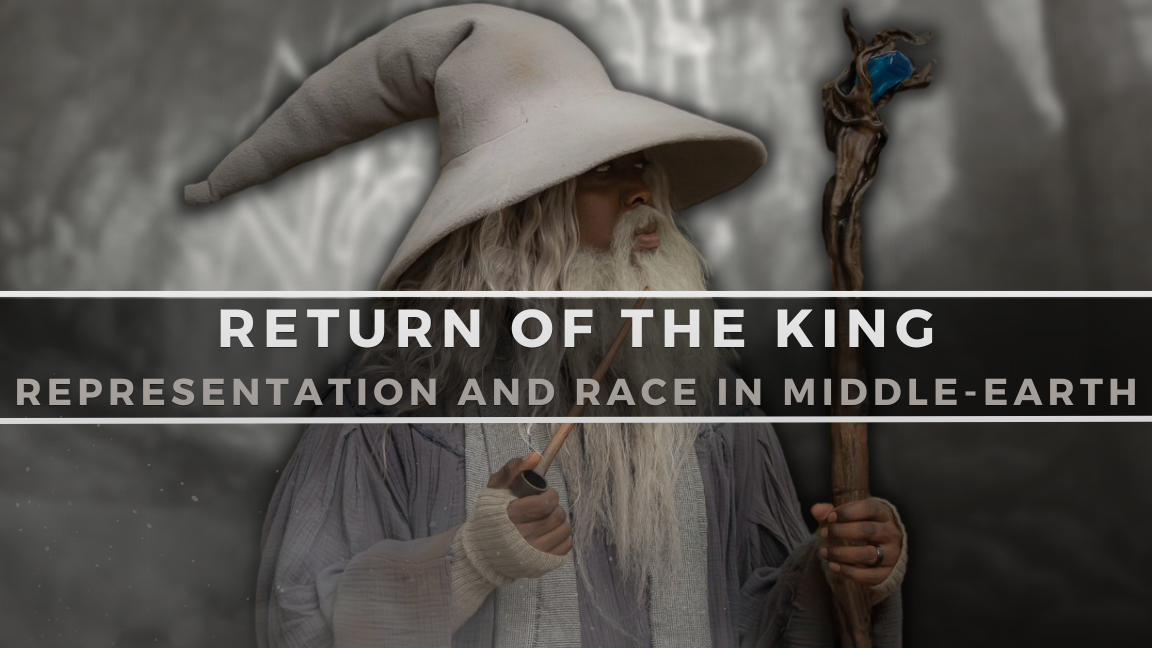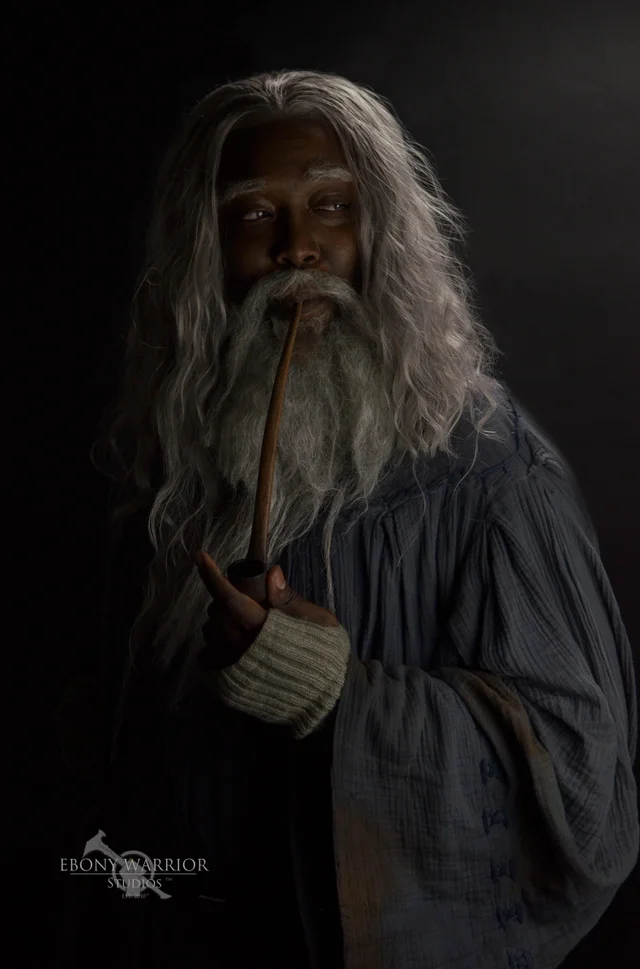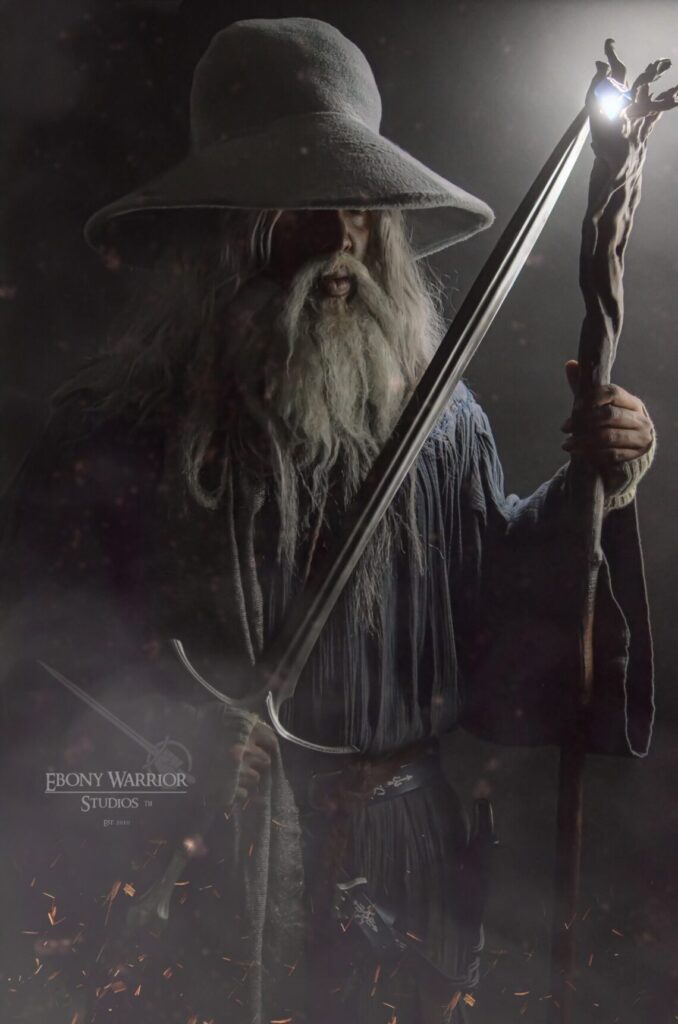The Return of the King: Representation and Race in Middle-earth

Xavier Conley as Gandalf the Grey | Courtesy of Ebony Warrior Studios
Joshua Clough of Preview Review here. Both The Lord of the Rings: Tales of Middle-earth and The Lord of the Rings Commander are now hot off the printers. Boosters have been opened, decks drafted and the legendary 1 of 1 One Ring has finally been found. This set is one for the history books, showing us what Universes Beyond can mean for Magic: The Gathering's commitment to inclusion for numerous people groups and demographics. By incorporating other franchises into the game of Magic, more and more people are discovering our beloved game. It's a win-win all around.
Wizards of the Coast worked alongside Middle-earth Enterprises to develop inclusive renditions of the characters we all know and love from Middle-earth. Beloved characters have been reimagined to encompass greater equality, diversity and inclusion than previous media renditions. Whoever you are, you'll be able to see yourself in Middle-earth, likely for the first time. Yet, this choice was not without the backlash of a loud few crying outrage at the depiction of Aragorn as a Black man. For the first time, Black and POC fans were able to picture themselves wearing the crown of Gondor, wielding Herugrim or battling to save Middle-earth from the forces of Sauron. These few began citing accuracy, researching quotes and using what they could to claim that this wasn't a true depiction of a King of Men.
So, I went the other way and asked one directly. Xavier Conley is a passionate fan and long-time adventurer of Middle-earth, a 3D fabricator, and a content creator who founded Ebony Warrior Studios in 2010. Xavier suffered from bullying throughout his school life, and it's from this experience that Ebony Warrior Studios was born. It's my honour to introduce Xavier in his own words with this exclusive article below, and it's our sincere hope that perspectives like his continue to enrich the worlds we enjoy and the games we play.

Xavier's Unexpected Journey
In 2016, I had the pleasure of attending DragonCon in Atlanta, GA for the third time. If you're not familiar with this convention, it's the largest cosplay convention on the East Coast, reaching nearly half a million attendees. During the Saturday of the Con, I wore my Batman cosplay from the video game Arkham Origins. Being a natural introvert, I thoroughly enjoyed the anonymity I had underneath the cowl. As I approached the main venue (The Marriott Marquis in downtown Atlanta), I saw a little boy with his mother walking towards me from the direction of the convention. He was wearing a black and yellow Batman costume, likely from somewhere like Party City. He saw me at a distance and immediately seemed to get excited, jumping up and down, tugging on his mother's arm. As I got closer, I saw he was pointing to me and then pointing to his skin. A massive smile was emblazoned on his face as we got within feet of each other. He beckoned me to kneel to his level, and I could feel the energy just radiating off his endearing grin.
When I got down to him, he looked me in the eye and said, "Batman, you're brown just like me! Does that mean I can be a superhero one day too?" I was so stunned by the question that I had to take a moment to catch my breath. Here I was cosplaying a character I had loved since I was a child and receiving the seemingly highest compliment one could ever hope to receive from a child. Tears were forming in my eyes as I composed myself, and took off my cowl to talk with the boy (my number one rule in my Batman cosplay is never to take off the cowl in public).
"You can be whoever you want to be, and don't ever let anyone tell you differently," I said through my pressed teeth, trying to hold back the torrent of tears just behind my eyelids.
On that fateful day in 2016, I learned the true meaning of why representation matters. Kids of color, like myself, grew up in worlds where we very rarely got to see themselves represented in the media that we watched. When we did get to see ourselves, it was as sidekicks or secondary characters: easily forgotten and dismissed. For this little boy at DragonCon, to be told there are no limits on what you can be (whether that be because of your skin color etc) was something that will now become a core memory for him, and I'm so grateful that I could be the source of that representation.
Journeying to Middle-earth
I grew up with a massive love of fantasy as a child, though there was a lot I didn't have access to; having been brought up in a conservative Christian household. Dragons, crystals, and wizards were things "of the devil". It's funny to think back on now, but it severely limited the media I was allowed to enjoy. Getting into The Lord of the Rings was no small feat. My mother had to be convinced of its "purity". I ended up writing a two page paper on why I should be able to read, watch and interact with Tolkien's IP. Allegories of good versus evil, angels versus demons, and Tolkien's close friendship with C.S. Lewis ultimately saw victory for me. Middle-earth was now mine to explore. I adored the books, and when I finally saw the movies, I fell head over heels for every single character.
A Shadow Over Inclusive Representation
There is only one Black character in the film version of the original series, a Gondorian Ranger seen in the background of the hideout scene in Ithilien. When I was younger, these things never really stood out to me, because you tend to see the world through rose-tinted lenses when you don't have adult responsibilities. As I got older and my experiences with racism and inclusion in fantasy spaces became broader, I noticed more and more how I never saw myself represented in these fantasy worlds. And it's not like Tolkien explicitly stated all of his characters were non-melanated in complexion. Samwise Gamgee, for example, was brilliantly portrayed by Sean Austin in the films, but his description in the books could lead one to believe he was Black or POC (person of color). This lack of representation didn't make me love the books and films any less, but it did make me desire to see myself in the world of Middle-earth even more.

Deconstructing Racial Stereotypes in The Lord of the Rings
When the Shadow of War video game was released we were introduced to the original character, Baranor, who is of Haradrim descent. Something (which was a bit of a dog whistle) that I have always heard in Tolkien spaces was that Black people have to be descended from Harad, the far south of Middle-earth. In the books, these lands are described as evil, and the men residing in them evil as well. Maybe dog whistle was too tame; more like a bullhorn siren. Baranor was cool, but I didn't like the idea of Black people only being allowed to come from "the bad place". I heard this sentiment repeated over and over when I cosplayed as a Gondorian Guard of the Citadel. In numerous forums and fantasy spaces, I told the original backstory I had created for my character Annungiltor. Part of that story was his family's long Gondorian lineage reaching back to Numenor. This was always met with some form of disdain or vitriol from commenters: "Maybe he could be from Harad". "Maybe he is adopted". "From a lore perspective, this does not make sense". Elves, dragons, and cave trolls abound in this fantasy world, but the very idea that my character could be Gondorian completely broke their suspension of disbelief, go figure.
A Battle Beyond Bias
Fast-forward to about a year later. I learned through my followers that Magic: The Gathering would be releasing a set of The Lord of the Rings cards. Someone asked me if I had seen the teaser card they had released for Aragorn, and I rushed to find it. I expected a new take similar to the portrayal done by Viggo Mortensen in Peter Jackson's film trilogy. The wave of emotions that overtook me when I saw a Black man with locs, as the King of Gondor. I cried my eyes out, because I finally got to see myself truly represented in my favorite fandom. No longer was I a side character, or a marked descendent of Harad. I was in absolute shock, probably the same emotions that little boy felt when he met a Batman that looked just like him. The emotions overflowed when one of the developers on the new Magic cards contacted me and said my Gondorian cosplay was an inspiration for Aragorn's new look. I felt like I couldn't breathe. After years of feeling sidelined in The Lord of the Rings spaces, here I was with a character design based off of me.
A King of Men for All People
Representation in fantasy spaces shouldn't be revolutionary, but until systems of white supremacy are dismantled and centuries of wrongs are righted, it will continue to feel extraordinary. This new wealth of Magic: the Gathering cards could see the welcoming of a whole new demographic of people who may not have taken part otherwise because they couldn't see themselves in the character's shoes. Compared to many other fandoms, fantasy spaces are some of the most inclusive and welcoming but there are still glaring issues with racism and gatekeeping. Through these new cards, little Black and brown kids like me will be able to easily insert themselves into the incredible lore/world of Tolkien as Eowyn, Theoden, Aragorn, Gandalf and other various races of characters. So many new characters of color are represented in the new cards, and we all deserve to enjoy that inclusion to its fullest. Representation matters, and this is just one of many steps on a journey to a place where all can feel welcome in The Lord of the Rings fandom.
A Fellowship to Celebrate and Share
I've had the honour of working with Xavier on this article, and if you'd like to see more editorial work from me, you can do so on EDHREC, where you'll find my articles on underrated Commander cards. Or you can hit me up on Twitter.
To see more of Xavier's cosplay work and commentary on social media, please visit him at the official Ebony Warrior Studios website, Twitter, and his Youtube channel.